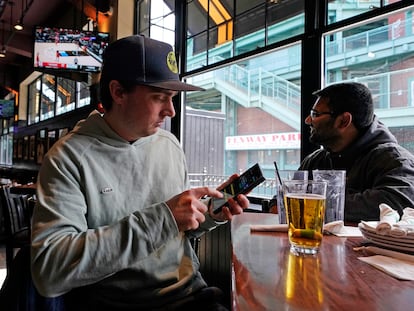The risks of ‘sharenting’: I am only three years old and already have more followers than you
Experts recommend thinking twice before uploading pictures of children to social media and call for the protection of their digital footprint


An ultrasound scan announced his arrival, and the congratulations and likes poured in. Then a picture in the hospital, after labor. One more, this time on vacation, splashing in the pool. Then dancing at a wedding. Even the day he made a mess in the kitchen, or when he fell and cried and laughed at the same time. Also one from the time he had to be taken to the hospital — nothing serious, thank God, but his parents were so scared! Not to mention his followers. This could be any kid; let’s say he is three years old, but they can be any age, really. Their entire lives are posted online, on a public profile, for anyone to see. It’s all there: their name, their age, who their relatives are, how their voice sounds like, the school they go to, what they like to wear, their favorite foods, their tantrums. Their online identities were not created by them, their digital footprint is beyond their control and, through their parents’ accounts, they have more followers than many of the readers of this article.
This phenomenon is known as sharenting. Educational psychologist Vanesa de la Cruz cites two reports from a few years ago to describe the panorama: “According to a study by the computer security company AVG, 81% of children have an online presence before they are six months old. Another study, from the University of Michigan, concluded that 56% of parents believe that some people share photos that could be embarrassing to their children.” De la Cruz, who works for the Fad Juventud Foundation in Spain, coordinates the Connected Education project, which trains families in digital education.
As social media has become an integral part of our lives, “many times, the families are not aware that they cannot control what happens with the information that they share,” explains De la Cruz. “They have to realize that the images could go beyond a private profile; when they are posted as a WhatsApp status, for example. Children can be vulnerable to identity theft, to become memes and be harassed by their peers, to end up in image banks for sexual purposes... But not only that: by sharing their private life, their personal matters are on social media,” she warns. “Sharing images is not a parental right,” she adds, emphasizing that in the case of public figures, “everything rises to the nth degree, with the added factor that children are exposed to hate messages, which can seriously hurt their self-esteem.”
Willow Smith, the daughter of actors Will Smith and Jada Pinkett Smith, told the digital magazine Girlgaze in 2017: “Growing up and trying to figure out your life… while people feel like they have some sort of entitlement to know what’s going on, is absolutely, excruciatingly terrible — and the only way to get over it, is to go into it.” She was 17 at the time. “You can’t change your face. You can’t change your parents. You can’t change any of those things. So I feel like most kids like me end up going down a spiral of depression, and the world is sitting there looking at them through their phones; laughing and making jokes and making memes,” she added. If you open up your Instagram right now, I guarantee you that you’ll see a photo or a video of someone’s child. At all hours, there are thousands of videos and photos shared, with hundreds of likes and comments.
María Lázaro, author of the book Menores y redes sociales [Minors and social media], believes that the difference between the exposure of children of celebrities and influencers years ago and what happens now is that “in social media the audience is multiplied by a thousand, and that reach is permanent. Before you were on television, but nobody could use that image; now it is amplified and remains indelible.”
Overexposing their private life
However, Lázaro widens the scope to include all children, not just those with famous parents. “It’s a double problem. On one hand, we want to teach our children not to overexpose themselves on social media when we are the first to do so, and on the other, we have taken the possibility of deciding and managing their digital footprint away from them.” Her recommendation? “Not to share photos, and if we do, to respect their privacy” in the image. Also, children should be involved in the decisions. “When you start to ask them if they want you to share a photo, they surprisingly begin to say no, especially when they hit their teens.”
A recent analysis by the Open University of Catalonia in Barcelona, Spain, warned about the dangers of sharenting, citing studies such as one by the University of Valencia that reveals that 72% of the material seized from convicted dual sexual offenders (that is, pedophiles who also physically abuse minors) were non-erotic or sexualized images of totally or partially naked children that they found in commercial sources or family albums. That is to say, they were normal photographs of everyday scenes.
A campaign to raise awareness among parents by the Anar Foundation — whose aim is to defend the rights of minors — exemplifies this with the fictitious case of Marina, a girl whose parents uploaded 200 photos and videos to the internet in her first year of life. By the time she is 13, there will be more than 2,000. Also in the campaign is one mother’s testimony, who prefers to remain anonymous. She says that she has gone from never uploading a photo with the faces of her children, who are now nine years old, to making sure that her private profile only includes people that she knows and trusts, so she can use it as a sort of photo album.
Meanwhile, one day she found on a website a picture of her children taken at a family photo shoot. “They had uploaded it without authorization.” It was a frightening find: “I don’t even want to look into it; I rather not to know if it’s anywhere else. But one day I realized that I want to have memories with my children, of their life at school and their activities with their friends. Covering their faces is like stealing their identity. I talk to them [about it], and they tell me if it’s okay for me to upload the pictures,” she says. Still, she admits that she is “horrified” to see some of her friends’ posts. “They have even shared images of their children in the hospital.”
Children are exposed to a reality that adults did not have to face, explains Lázaro, who mentions examples in Austria and Italy of minors who have even taken legal action against their parents for sharing too much of their lives online.
Awareness is key
Cristina (her name has been changed to protect her privacy), the mother of a six-year-old boy, says that she has many doubts regarding how to educate her son in an environment where social media is ubiquitous. “I think there is an age to exist online, and for now I want to keep my child’s footprint in the digital world as small as possible. This is why I only share his photos on a family WhatsApp group, and we have agreed that they cannot be used outside of it.”
Nacho Guadix, head of education and digital rights for UNICEF Spain, recommends, firstly, to learn about the privacy policies of social networks. Many families “follow suit without giving it much thought,” he says. “They share images out of pride and the need for recognition, or to create attractive content.” In addition, “barely 13% of the parents of teenagers between the ages of 12 and 16 limit the content that their children see online. This is a sign of how little risk families see in this practice,” he concludes.
Guadix calls for awareness: “There are future risks that are difficult for us to even imagine at this point. For example, with artificial intelligence. It is not about living in a cave; we are not in favor of a total ban, but it is good to ask ourselves what we gain by publishing the image. If there is no benefit, it’s better not to publish it. And when we do, we should decontextualize it as much possible, without sharing information about where the school is or what park you go to. Pedophiles are super clear on how to pull that thread.”
Sign up for our weekly newsletter to get more English-language news coverage from EL PAÍS USA Edition
Tu suscripción se está usando en otro dispositivo
¿Quieres añadir otro usuario a tu suscripción?
Si continúas leyendo en este dispositivo, no se podrá leer en el otro.
FlechaTu suscripción se está usando en otro dispositivo y solo puedes acceder a EL PAÍS desde un dispositivo a la vez.
Si quieres compartir tu cuenta, cambia tu suscripción a la modalidad Premium, así podrás añadir otro usuario. Cada uno accederá con su propia cuenta de email, lo que os permitirá personalizar vuestra experiencia en EL PAÍS.
¿Tienes una suscripción de empresa? Accede aquí para contratar más cuentas.
En el caso de no saber quién está usando tu cuenta, te recomendamos cambiar tu contraseña aquí.
Si decides continuar compartiendo tu cuenta, este mensaje se mostrará en tu dispositivo y en el de la otra persona que está usando tu cuenta de forma indefinida, afectando a tu experiencia de lectura. Puedes consultar aquí los términos y condiciones de la suscripción digital.
More information
Archived In
Últimas noticias
Most viewed
- Sinaloa Cartel war is taking its toll on Los Chapitos
- Oona Chaplin: ‘I told James Cameron that I was living in a treehouse and starting a permaculture project with a friend’
- Reinhard Genzel, Nobel laureate in physics: ‘One-minute videos will never give you the truth’
- Why the price of coffee has skyrocketed: from Brazilian plantations to specialty coffee houses
- Silver prices are going crazy: This is what’s fueling the rally










































